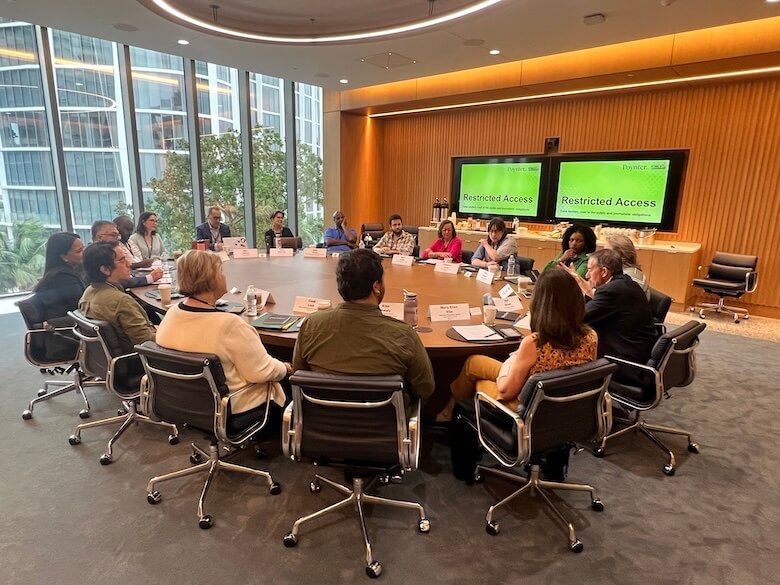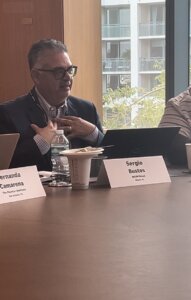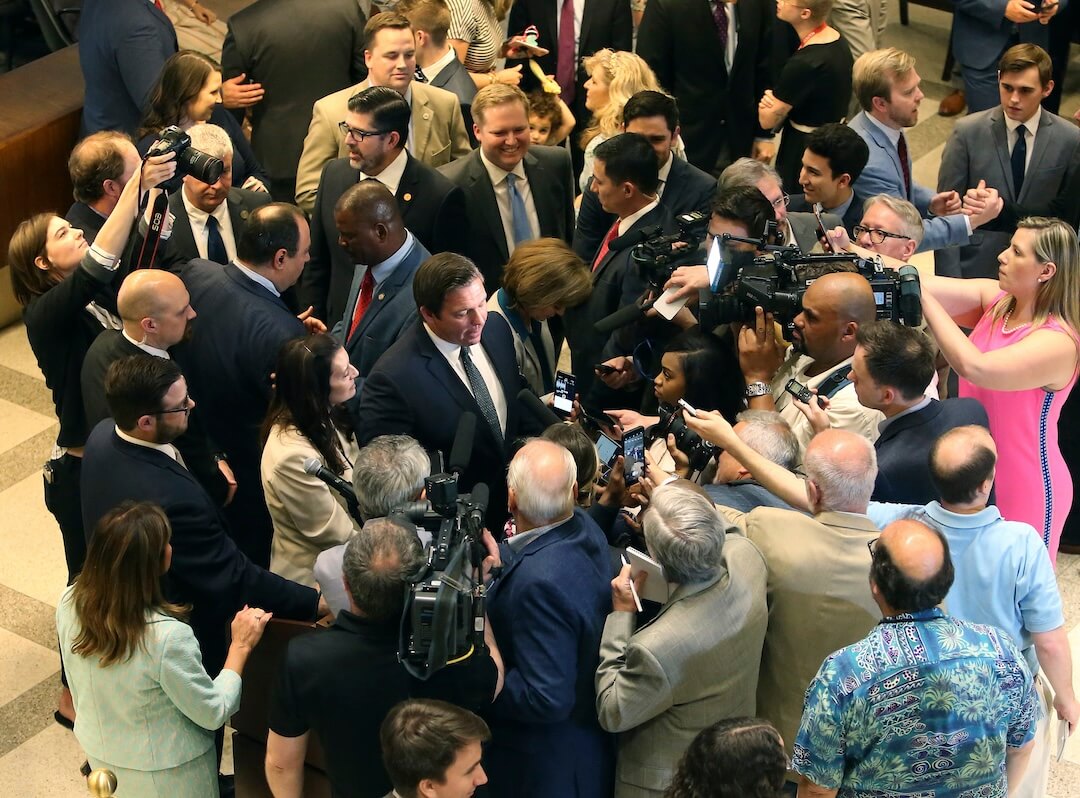This week, Poynter is publishing installments from “Shut Out: Strategies for good journalism when sources dismiss the press,” a report from a symposium by the Craig Newmark Center for Ethics and Leadership about the growing trend of sources bypassing independent reporting.
You can read the full PDF of the report here, or return each day for a new topic of discussion.
The Democratic-controlled New York State Assembly lifts all its COVID protocols — except the one that lets journalists within an arm’s reach of lawmakers.
The sheriff in Daytona Beach, Florida, refuses to alert the local paper to news conferences or comment about crimes after a social media dispute over coverage.
A reporter for the nonprofit Colorado Sun is removed from an important Republican Party meeting after being told the party chair thought her reporting was unfair.
Relationships between public officials and journalists have always been fraught. There has long been a tension over how and when to make public the, well, public’s business.
But that tension has deteriorated to unabashed hostility. The result: Journalists are denied access needed to hold the powerful to account, and the public is denied information about how its money is spent or about the actions of those elected to serve.
At the Poynter Institute, we have been collecting examples, talking with professionals and contemplating strategies to stem this erosion of access that undermines the value of independent reporting that helps citizens participate robustly in their civic life.
Journalists tell us they are increasingly shut out from attending important events, or thwarted in trying to report on matters of central interest to their local news audiences. When journalists seek access to sources, especially those in positions of power, they are too often met with tactics aimed at denying, delaying and distracting them from doing their jobs — and frequently denounced or harassed for trying.
It happens in all realms of coverage, from national and state politicians to local public officials, to private businesses to athletes and celebrities. Often it includes the illegal denial of access to public places and public records.
Certainly, journalistic work can have its detractors, and powerful people have a rich history of balking at efforts to shine a light on their actions. But political polarization, repeated vitriol from those who would demonize the media, and a breakdown of relationships between journalists and the people they cover have made the problem more severe.
When journalists are shut out, the public is shut out. And though those in power declare they prefer to reach consumers directly through other means, such as social channels, they are often undermining a core component of the public’s power to frame its own view: independent reporting.
After collecting a range of case studies, the Craig Newmark Center for Ethics and Leadership at the Poynter Institute convened a one-day symposium of journalists and thought leaders at the offices of the Knight Foundation in Miami, Florida in late 2023. The goal was to identify techniques related to journalistic craft to improve trust, transparency and truth-seeking. The group represented a breadth of expertise across coverage areas and a diversity of experience, including journalists and experts in politics, ethics and media law.
We posed this central question:
How must journalists adapt their work to serve their audiences with complete, fair and accurate reporting when key sources and newsmakers have opted out?
This report expounds on this central answer:
Even amid challenging economic pressures, news organizations must make a fresh commitment to beat reporting and source relationships. Though we tout these as fundamentals of journalism, we can elevate our execution of them. Journalists must reduce reliance on email interviews, staged events, official proclamations and contact with usual suspects.
What else can help? In summary, some key strategies offered by our journalist experts:
- Let go of the fear that we don’t want to “become the story,” and instead tell your audiences how you tried to obtain the information. Be willing to offer audiences more detail about when sources would not cooperate. Remember: the lack of cooperation is essentially with the public.
- Rather than focus on who’s not talking, find out where sources are talking and spend energy on time and relationships there. The hard part: an important recommitment to reporters getting out of the office.
- Partner rather than compete with other journalists in order to cover more ground. There is power in numbers and sharing interviews and other reporting is cost-effective.
- Pool resources with others to invoke legal rights to public documents, and be willing to go to court to fight for access. And explain to your audience why the legal efforts are on the community’s behalf.
“Not all, but many who do the public’s business have taken a misguided and unfortunate stance that they are under no obligation to make themselves or their work available for independent journalistic review, even though it is an essential component of our civic life,” said Neil Brown, Poynter president.
“Both sides have this in common: They serve a public audience. So journalists need to find new sources and not be thwarted in telling people what they have a right to know. Putting value on source development and working to establish relationships with subjects and with audiences is source development and working to establish relationships with subjects and with audiences is a pivot away, at least a little, from the high-volume, low-value touches that have defined reporting in recent years. We understand the economic and audience demands of around-the-clock news posting. But to promote issues of trust and grow the value and service of independent journalism, we must recommit to these relationships. It is essential to complete and accurate reporting.”

Journalists and other experts discuss the challenges of ensuring complete coverage when some sources refuse to engage during a symposium in Miami in October 2023.
When sources won’t engage with journalists
More than a decade ago, Florida’s then-Gov. Rick Scott began taking his news conferences on the road, often in smaller towns, away from the informed questions of Florida’s plugged-in press corps in Tallahassee. Mary Ellen Klas, a politics and policy columnist for Bloomberg Opinion and a longtime Florida statehouse reporter, said this allowed Scott to avoid deeper scrutiny by “entertaining questions from local television reporters who often had more of a superficial understanding of the issues and rarely challenged the governor.”
Ron DeSantis, Florida’s governor since 2019 and a recent presidential candidate, took this practice to a new level, Klas said. One memorable example occurred in 2021, when he announced he wanted to ban local governments from adopting COVID-19 health protocols.
“Rather than conducting the news conference in Tallahassee, where he would face questions from capitol reporters who had followed the issue, he flew on the state plane 105 miles to Panama City Beach where his staff assembled a cheering crowd of supporters,” Klas said. “… He got no questions. This pattern of avoiding questions, … and conducting the event as if it were a campaign rally, has continued to this day.”
The result of these and similar practices is to replace journalistic scrutiny with stagecraft.
Patterns of media evasion and selective engagement have become the norm for many newsmakers. They may work with media that are friendly to or aligned with the source’s views, resulting in little to no accountability questions or pushback. Many sources who once engaged with reporters, even if grudgingly, have become masters of media avoidance.
When DeSantis went to Pittsburgh to campaign for Doug Mastriano, a Republican running for Pennsylvania governor in 2022, the event’s sponsor, an advocacy group called Turning Point Action, listed rules journalists had to agree to before entering the event.
“They wanted us to agree that all audio, video, anything we recorded for broadcast, they would have access to and would get to look at it,” said Cindi Lash, vice president of news for WESA public media, Pittsburgh’s NPR news station. “And if they wanted to use it for campaigns or commercials or whatever, they would do so.”
Lash’s team covered the event without entering the hotel. They interviewed people outside the event, which was eventually livestreamed so they could view what was said.
Because of several factors, including the 24/7 cable news cycle and social media, reluctant public figures can avoid journalists but still reach a receptive audience.
Sergio Bustos, vice president of news for WLRN South Florida Public Media, said newsmakers know their audience “and tend to gravitate toward a friendly journalist or host and avoid those that they deem ‘hostile’ or who would challenge them.”
He added, ominously: “I don’t think the public cares. They, I believe, compound the problem because they are tuning in or clicking on TV or digital news outlets that lean heavily toward their political point of view. MSNBC (liberal). Fox News (conservative).”
Hollis R. Towns, a longtime newspaper news executive who is now vice president of content and editor-in-chief of the Alabama Media Group, has a similar view regarding cable news. Towns said newsmakers often believe the media is unfair and out to get them. “Many have written off the media as left-wing and biased,” he said. “In many ways, they shut off media and instead only grant interviews to outlets that support their political views.”
April Schiff, a political consultant and president of Strategic Solutions of Florida, as well as an elected Republican Party committeewoman in Tampa, agreed that some newsmakers lack trust in the media. Because they have the tools and methods to engage with the audience, Schiff said they have become comfortable working without traditional media.
“Officials can now launch their own messages on multiple platforms to reach constituents and the public within minutes and achieve a wider, more controlled message delivery,” she said.
She added that pay-to-play platforms allow for direct publication of a specific communication with little chance of editing or altering the original message.
What is a reporter to do in this evolving new world of limited access? While sources may attempt to seize control of their narrative, journalists still have plenty of options at their disposal to keep their audiences informed and sources accountable.
The strongest points of consensus at Poynter’s symposium were recommendations that centered on a recommitment to good beat reporting: getting out of the office and building personal relationships with sources, ensuring the source pool includes ground-up, community sources, and developing subject-matter expertise to present information even if a source isn’t giving it to you.
The panel acknowledged that the pandemic, devastated newsroom budgets and the changing information landscape all make this a real challenge, but stressed how important it is for an informed audience.
Recommendation: Build new source relationships
Expanding your network of sources beyond the “official” and into the community offers more ways to get at the story. It also increases the expertise of the reporter on their beat, which in turn establishes credibility and trust with other sources.
Justin Garcia, state and local accountability reporter for the Tampa Bay Times, said it takes time and effort to build trust with community sources, but it’s worth it.
In addition to school board members and union representatives, talk to students, parents, custodians and school volunteers. In addition to police officers, talk with their neighbors or friends.
“These people in the community — you don’t realize it — are well sourced. They have friends and family members in police departments and sheriff’s departments,” he said. “They’re getting to know you, they’re going to trust you. They’re talking to the people in those departments and they’re able to feed me information” that can help narrow a public records request.
“It doesn’t mean you just completely burn your sources that are higher up. That doesn’t mean that you neglect them. You still do still foster those.”
He added: “For me, it’s been about touching base with where the community is, making sure the community trusts you enough to give you that important information.”
As local news staffs have shrunk, ties to the community have weakened. Repairing these relationships requires that reporters invest time in rebuilding these ties. Poynter senior vice president Kelly McBride, chair of the Newmark Center for Ethics and Leadership, teaches newsrooms how to reframe traditional crime coverage. Over six months, a small newsroom team meets with Poynter instructors and other newsrooms to rethink coverage standards, shifting from simply documenting specific episodes of crime to explaining trends.
When news organizations make this change successfully, they naturally increase the amount of insight and information gained from community sources, and they minimize their reliance on information handed out by law enforcement. The result is a more accurate picture of public safety concerns and solutions.
“Every newsroom declares it wants to be the ‘trusted source’ of news,” McBride says. “Rooting coverage of public safety in the concerns and experiences of the community makes the coverage more accurate and complete, and therefore more trustworthy.”
The attendees at Poynter’s symposium also noted the importance of routine beat coverage: stories that aren’t landscape-shifting investigations, but those that feature the community or address issues those in the community — potential sources — feel are important.
For Garcia, editor buy-in is key. “Sometimes they’re like, well, that’s not sexy enough. That’s not gonna get enough clicks. That’s kind of insider. But people really pay attention and it builds that trust.”
News leaders should incentivize giving their reporters the ability to get out into the community to talk to people. Rebuilding — or building for the first time — in-person connections with sources can open side doors to stories.
Mike Wilson, deputy editor of The Great Read feature of The New York Times and the former editor of The Dallas Morning News, said upon reflection he would have invested less in social media and breaking news desks in Dallas that essentially work inside an office and invested more in reporters who went places and talked to people.
“I know as a journalist that you get stories by showing up,” he said.
Recommendation: Look for where they are talking

Sergio Bustos, vice president of news for WLRN South Florida Public Media, speaks at Poynter’s ethics symposium in Miami.
Bustos of WLRN tells his editors and reporters: “They may not be talking to us but they are talking to somebody. This is especially true with conservative politicians, mainly backers of President Trump. We do find them on X, Facebook, or Rumble or YouTube. Newsmax is especially good for getting conservative politicians.”
His other strategy is to find transcripts. Most of the major cable networks, CNN, Fox News, and MSNBC, publish transcripts from their shows.
“Another great source is ProPublica’s Recent Congressional Statements database. It contains the latest press releases, statements of House and Senate members. It’s not comprehensive, but it’s very timely.”
Recommendation: Speak up. Who else will?
Our panelists also said it’s crucial for journalists to be transparent when a source shuts down or limits access in the hope of limiting accountability.
A simple “could not be reached for comment” is not enough. Journalists should make an effort to explain to the audience not only that the source is unwilling to participate, but also the context and ramifications of that decision. That shows the reporter is holding the newsmaker accountable and explaining that by withholding information from the journalist, they are also shutting out the public.
“Journalists are historically hesitant to make themselves the story and/or worried that admitting the government is stifling their ability to report the news is a confession of weakness,” said Seth Stern, director of advocacy at Freedom of the Press Foundation. “That needs to stop.”
He said journalists should write about it. “Make clear in the story that you would’ve liked to attend the event yourself or speak to the official or their staff but you weren’t allowed to do so. If they believe the coverage is biased, they have themselves to blame, and perhaps they’ll reconsider for next time.”
In the case of the Pittsburgh campaign event with DeSantis and Mastriano, WESA released a pre-event story on the campaign’s “ground rules” with the headline, “Rules for covering DeSantis visit to Pittsburgh pose ethical quandary, experts say.” The day of the event, another story explained why WESA chose not to comply with the campaign’s rules:
“Abiding by those conditions could pose a challenge to journalistic ethics. For example, NPR’s Ethics Handbook, which guides WESA journalists in their work, stipulates that reporters must maintain their independence. Among its principles is ‘Don’t allow sources to dictate our coverage.’ We don’t allow sources to dictate how a topic will be covered, or which other voices or ideas will be included in the stories we do.”
This report was edited by Neil Brown and Jennifer Orsi.
Coming Tuesday: Open records: A guide to help the owner — the public — have access








